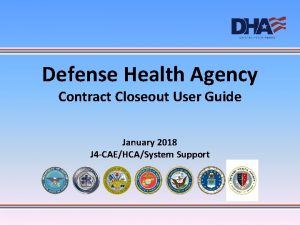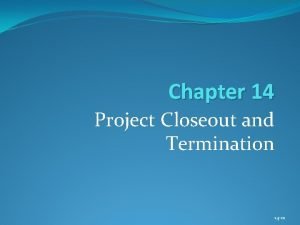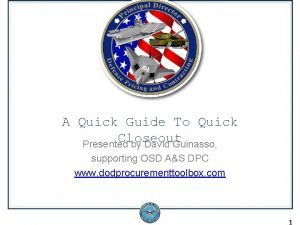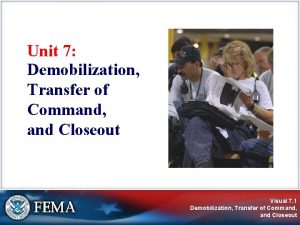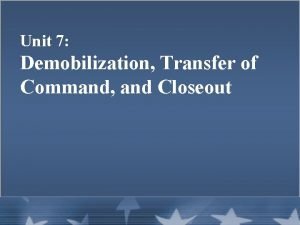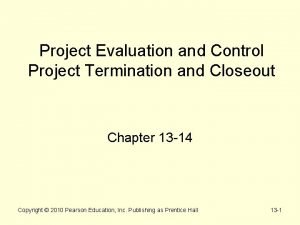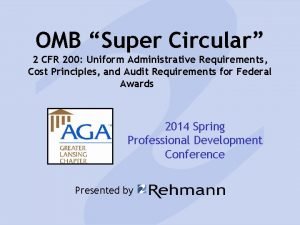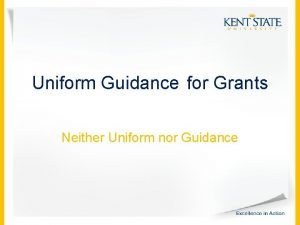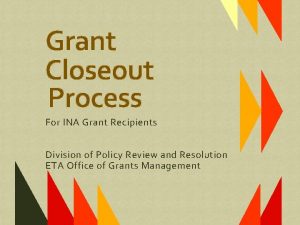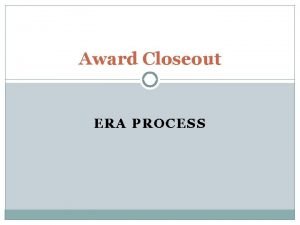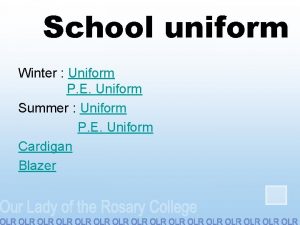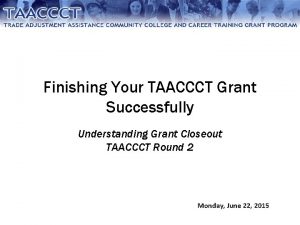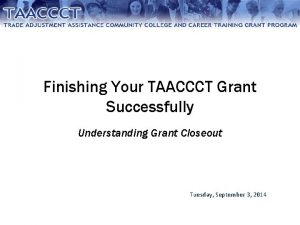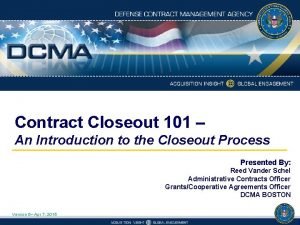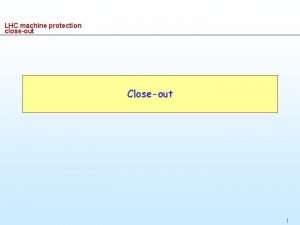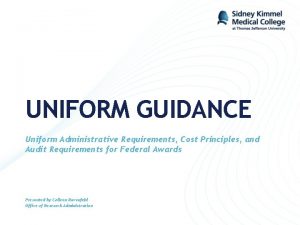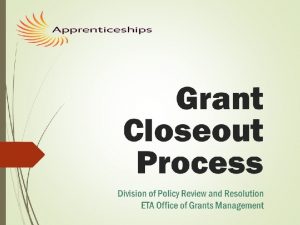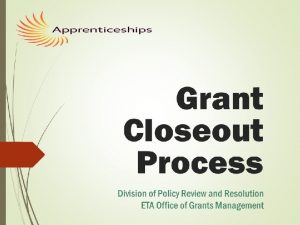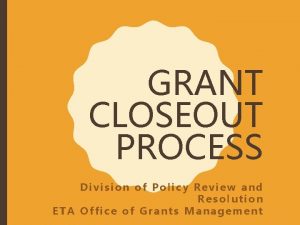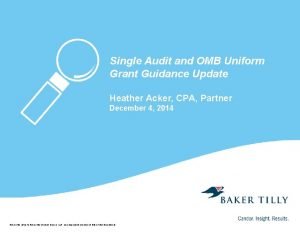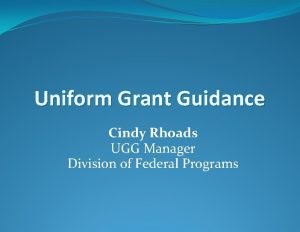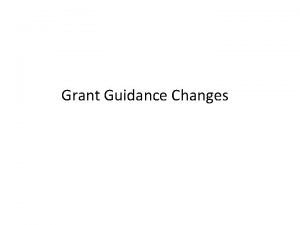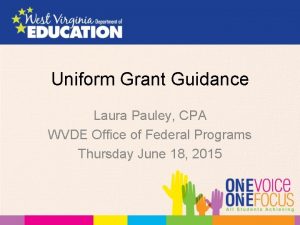Uniform Guidance the Grant Closeout Process 1 UNIVERSITY





















- Slides: 21

Uniform Guidance & the Grant Closeout Process 1 UNIVERSITY AREA MARCH 16, 2015 SHEILA DOYLE & LAURA TOBIN KETCHUM OSP, RESEARCH FINANCE

Collaborating on Closeout 2 • Background on Federal Regulations • Our shared objectives • Harvard Data: Where do we stand? • Discussion: What is closeout and what are the current challenges • Current Sponsored Financial Reporting (closeout) Policy • Systems & Operations Opportunities • Feedback

Background: The catalyst for timely close-out? A Government Accounting Office (GAO) study 3 GAO Study conducted in 2011 As the federal government was confronting long-term fiscal challenges, it became critical to improve the efficiency of federal grant processes, including grant closeout procedures, that allow for the return of unspent balances to the Treasury. What GAO found � ~ $800 M of undisbursed balances remained in grant accounts several months after grant expirations. � ~ $111 M of undisbursed funds remained unspent more than 5 years past the grant end date, including $9. 5 million that remained unspent for 10 years or more. � GAO found that raising the visibility of the problem within federal agencies can lead to improvements in grant closeouts. � Closeout is an important final point of grants accountability. It helps to ensure that grantees have met all financial and reporting requirements. � Closeout allows federal agencies to identify and redirect unused funds to other projects and priorities as authorized or to return unspent balances to the Department of the Treasury. What GAO Recommended OMB revise future guidance (UG) to better target undisbursed balances and instruct agencies to take action to closeout grants that are past their end date (de-obligate and redistribute or return to treasury). Source: http: //www. gao. gov/products/GAO-12 -704 T

Federal Agency Action 4 Uniform Guidance re-affirms the 90 -day deadline: • “The recipient must submit all financial, performance or other reports, as required by the award’s terms and conditions, no later than 90 calendar days after the end date of the period of performance. It is critically important to be aware of the requirement that the recipient must liquidate all obligations incurred under the federal award not later than 90 calendar days from the award end date. ” …But individual agencies are making their own decisions about how to implement the Guidance: � � � NSF will allow 120 days to draw NIH will allow 120 days to submit final FFR and draw Other agencies are still at 90 days (Dept of Ed, Do. D…) Draws are final after agency deadlines. FFRs and draws still due at Day 90 until formal announcements made! Agency actions to date move toward accountability, transparency, and deadline enforcement : � � � HHS and NSF: pooled draw (G) to grant-by-grant draw (P) NSF now cutting off draw at Day 90 and strictly enforcing NCE rules Dept of Education has always de-obligated after day 90 DHHS and other federal agencies: plan to de-obligate after day 90/120 Other agencies list funds as “expired” after day 90.

Shared objectives 5 �Mitigate financial risk Ø Ø Fully recover dollars incurred on research sponsored by third parties. Implications: cost of research at Harvard is subsidized by nonsponsored funding when grants don’t fully pay cost of research. �Mitigate reputational risk Report timely and accurately to sponsors Implications: frequent revisions to financial reports and failure to meet deadlines raise flags for audits, indicate poor internal controls and processes. OMB focus on effective internal control environment. May impact future funding for PIs, relationships with collaborators, audits

A “certifying official” signs every federal invoice and financial report. 6 Certification By signing this report, I certify to the best of my knowledge and belief that the report is true, complete, and accurate, and the expenditures, disbursements and cash receipts are for the purposes and objectives set forth in the terms and conditions of the Federal award. I am aware that any false, fictitious, or fraudulent information, or the omission of any material fact, may subject me to criminal, civil or administrative penalties for fraud, false statements, false claims or otherwise.

The volume of grants management work has increased…. . 7

Harvard’s sponsored reporting and invoicing: July-Dec 2014 8 Harvard Report & Invoice Volume, July-Dec 2014 1200 1000 800 600 400 200 0 July Aug FFR Sept Non-Fed FR, Invoices, & Reviews Oct Nov Dec Automated Invoicing & FR (Portal) Ø FRAP automated 600+ items/month Ø Monthly average volume of 400 manual financial reports, invoices for entire University Ø Federal FFRs: small #, large dollars, high risk

Data: Another cut at University Workload – Last 6 Months July Report August Reconcile Federal Financial Reports, Invoices, & Reviews Portal Automated Other Work October November December 66 Report FFRs September 22 Draft Report Reconcile Draft 77 77 61 Report 31 318 338 368 333 340 281 627 511 556 579 611 667 Collections, Reconciling Accounts, Segment Closeout, GMAS financial set-up, Trainings, Sponsor outreach, Client Meetings and Outreach

University FFR Submissions by Month: Calendar Year 2014 10 90 greater than 10 days late under 10 days Late On time 80 15 70 60 9 7 50 2 15 40 30 20 6 38 10 6 3 12 0 jan Quarterly % on Time feb 5 9 29 70% 6 apr may 36 51 7 7 2 38 26 8 11 8 mar 2 6 6 28 14 17 15 7 jun 51% jul aug sep 52% 288 190 478 60% 15 10 2 Total Last 12 Months On Time Late Total FFRs oct nov dec 69% • 60% on time, 40% late • CY 2015 target: 100% • We risk write-offs for any late FFRs / draws

FY 14 Expenditure activity after award end 11 FY 14 Transactions After End Date on Fed Awards between 60 and 90 days expenses added after 90 days expenses removed $ $ 7, 353, 873 (6, 370, 568) expenses added $ expenses removed 3, 022, 018 $ (2, 975, 288) Expenses ($000) posted after 90 days. Total: $3 Million Lab Svcs $ 58 $ 222 Other • • • Sponsors will cut off the draw at 90 -120 days Data will help Working Group prioritize and key-in on particular areas Combination of critical system improvements and operations improvements Sal & Fringe 33% $ 402 Tuit & Stipend Supplies, Prof Svcs $ 800 $ 206 Sub- $ 733 contracts Subs, supplies, Prof Svcs = 39% * Excluding F&A = $2. 4 M

Discussion: What is “closeout” and what are the “closeout” steps? 12 � Closeout – a 90 day process to report, settle (cash) and close. � Steps Prepare Review & Reconcile Analyze Communicate Prepare to finalize, close Facilitators: � Sheila Doyle, OSP � Laura Ketchum, OSP

Discussion: what drives late reconciliation and reporting? 13 Ø What are some of the pain points and “work- arounds” that departments currently experience/use to be sure they manage awards effectively, recover all money spent, report accurately and fulfill all sponsor requirements? Ø What are some ongoing gaps or challenges? Facilitators:

The final 30 days of the reporting period 14 �In the interest of transparency …. here is what OSP does in final 30 days (Current State) OSP Sends Drafts (Day 60 -75) Department confirms final figure OSP Reviews for compliance; OSP and Dept process final adjustments OSP sends for signoff OSP Submits �Suggestion: submit FFRs 10 business days before the due date to allow time for issue resolution and draw Bulk of time spent here Need more time for problemsolving before draw

Current Sponsored Financial Reporting Policy (http: //osp. fad. harvard. edu/content/financial-reporting) 15 Current policy “The Federal Financial Report preparation process requires the department to complete account reconciliation and ensure all appropriate charges are posted to the G/L within the first 60 days of the 90 -day reporting period” What is new? v Agencies enforcing the 90 (120) day deadline. Why? v GAO report => Uniform Guidance from OMB v Federal agencies will de-obligate funds in the letter of credit payment system after day 90 (120). They want usto fully liquidate! v Promotes proper stewardship of Agency funds, Harvard funds.

Concerns with current sponsored financial reporting policy 16 • Not implemented / enforced • No process to manage exceptions and requests for deadline extension (must be rare!) • Needs to consider systems challenges / limitations • Consider 90 / 120 day draw cutoff • Consider FRAP processes Sponsors decide whether or not to accept financial report revisions or reimburse award expenditures after day 90. We will do everything we can to make the case to revise and to collect if the case is strong/supportable. Risk ultimately resides with department where grant was managed.

Working Group Goals 17 �Identify best practices for grant management What approaches have been used successfully to improve timeliness and accuracy? �Work with Central partners to improve efficiency and working relationships �Work-stream groups around known problem areas �Map out and enhance financial reporting & closeout process between OSP and departments

We need a clear timeline for the reporting/closeout period ü Monthly automated report to Departments: Awards expiring in next 90 days ü Client engagement meetings 3 months before award end date 2 months before award end date 1 month before award end date AWARD END DATE GL Close 1 month following end date ü Department commits to reviewing award expenditures preparing for final confirmation. ü OSP notified of pending adjustments or outstanding items. 1 ½ month before report due date ü OSP submits INITIAL DRAFT financial report to Dept. DAY 90 2 months following end date FINAL DRAW 10 days before final due date 2. 5 months following end date

Supporting the 90 -120 day timeline: OSP’s Plan 19 � Initiate a Working Group consisting of School, Department and Central Research Administration Leadership/Pre-Award staff to identify: System deficiencies Process deficiencies Training gaps for staff involved in grant financial management. � Monthly reporting to Orgs (Departments) for funds with financial reports and invoices due in the next 60 days. � Initial draft FFRs to be sent to dept. 45 days before due (1/2 thru reporting period). � Draft subcontract invoices (where Harvard is the sub) to be sent to departments 15 days before they are due (on day 45) so that final confirmation is possible by day 55 and submission possible by day 60 (our terms). � Research Finance enhanced cash management efforts: � � � New monitoring reports developed to closely monitor LOC awards as they approach their end date, Weekly LOC draw reviews for all Federal LOCs. Enhancing resources in Cash Management (reporting, personnel and School teams).

Feedback, Observations after 3 sessions 20 Feedback � Some people think the sessions were going to be more about the “how tos” of close out. So we know we should develop a session on close out…. . or maybe we call it Best Practices for Grants Financial Management and Closeout… � Some people say that they simply can’t keep up/take another central imposed demand…. but we only the messenger and the middleman…. . rules haven’t changed (yet), behaviors of Feds have. � Workgroups will be great to get at these issues. � People have been appreciative of the collaborative tone. � People are tired of hearing how many unreconciled accounts there are Observations � Is this more a conversation about grant financial management practices than just grant close-out? � RE: updating our Financial Reporting Policy…. there is discussion around incorporating Grant Financial Management Guidelines into the Sponsor Expenditure Guidelines. The working group will decide. � We need to establish who does what in the entire life cycle of managing the grant. There isn’t enough clarity around this. � Institutionally we are just cracking the surface on training/on-boarding our staff…there are pockets of excellence but really nothing that is “required” for staff managing the finances of grants. Training is really inefficient and spotty at best. There is a pilot Learning Management System (LMS) taking place that addresses this need for certifications depending on role. � Systems: numerous and not connected. Yet, trending in the right direction?

System and Process Improvement Opportunities 21 Systems Conversations with A/P Leadership planned to discuss processes and turnaround time. Innovations at Schools – “Prompt” for svc center management. GMAS 2. 0, (financial management a focus: budgets, close-out, account management). Institutional support for FRAP to ensure its stability, fix known bugs and sustain automated reporting. Dashboard projects - Allow PIs, leadership, departments to pull real-time sponsored data. Operations Monthly account/fund reconciliations a must. Streamline, improve communication with service centers re: internal billing process. Monitoring subcontracts against budget. Strategies for collecting sub- invoices, escalation/involving Financial Leadership. Enhanced focus on cash management and award reconciliation. Balanced approach between pre- and post -award management.
 Incisal guidance angle value
Incisal guidance angle value Direct vs indirect guidance
Direct vs indirect guidance Contract closeout
Contract closeout Project termination issues
Project termination issues Quick closeout
Quick closeout Project closeout presentation
Project closeout presentation Demobilization plan template
Demobilization plan template Transfer of command
Transfer of command Putting it all to bed during project closeout includes
Putting it all to bed during project closeout includes Omb super circular 2 cfr 200
Omb super circular 2 cfr 200 10% de minimis indirect cost rate uniform guidance
10% de minimis indirect cost rate uniform guidance How do you classify uniform and non-uniform mixtures?
How do you classify uniform and non-uniform mixtures? Grade 7 science unit 3: mixtures and solutions answers
Grade 7 science unit 3: mixtures and solutions answers Aliran seragam adalah
Aliran seragam adalah Linear motion images
Linear motion images Pusan national university uniform
Pusan national university uniform Japan school uniforms
Japan school uniforms Chulalongkorn university faculty of arts
Chulalongkorn university faculty of arts Korea university uniform
Korea university uniform Html q
Html q Hình ảnh bộ gõ cơ thể búng tay
Hình ảnh bộ gõ cơ thể búng tay Frameset trong html5
Frameset trong html5


